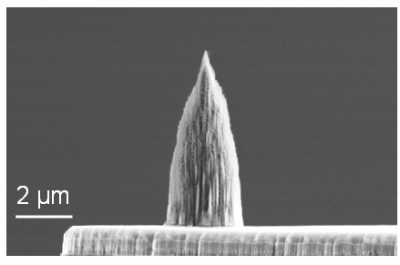Nov 16 2012
One of the most promising innovations of nanotechnology has been the ability to perform rapid nanofabrication using nanometer-scale tips.
 Diamond nano-tip integrated onto the micro-heater of a doped silicon microcantilever. The tip has a radius of 10 nm. (Credit: William King)
Diamond nano-tip integrated onto the micro-heater of a doped silicon microcantilever. The tip has a radius of 10 nm. (Credit: William King)
The fabrication speed can be dramatically increased by using heat. High speed and high temperature have been known to degrade the tip… until now.
"Thermal processing is widely used in manufacturing," according to William King, the College of Engineering Bliss Professor at the University of Illinois at Urbana-Champaign. "We have been working to shrink thermal processing to the nanometer scale, where we can use a nanometer-scale heat source to add or remove material, or induce a physical or chemical reaction."
One of the key challenges has been the reliability of the nanometer-scale tips, especially with performing nano-writing on hard, semiconductor surfaces. Now, researchers at the University of Illinois, University of Pennsylvania, and Advanced Diamond Technologies Inc., have created a new type of nano-tip for thermal processing, which is made entirely out of diamond.
"The end of the diamond tip is 10 nm in size," King explained. "Not only can the tip be used for nanometer-scale thermal processing, but it is extremely resistant to wear."
The research findings are reported in the article, "Ultrananocrystalline diamond tip integrated onto a heated atomic force microscope cantilever," that appears in in the journal Nanotechnology. The study shows how the 10 nm diamond tip scans in contact with a surface for a distance of more than 1.2 meters, and experiences essentially no wear over that distance.
"The scan distance is equal to 100 million times the size of the tip," said King. "That's the equivalent of a person walking around the circumference of the earth four times, and doing so with no measurable wear."
"The robustness of these diamond-based probes under such harsh conditions—high temperatures and stresses in an oxidizing environment—is quite remarkable and exceeds anything I've seen with other AFM probes," said Robert Carpick, professor of mechanical engineering and applied mechanics at University of Pennsylvania and co-author on the study. "This level of durability combined with the multifunctionality of a thermal probe really opens up new applications for the AFM."
"We are pleased with the results since they prove once again the superiority of diamond tips to any other types of probe tips when it comes to low wear and resistance to harsh environment," said Nicolaie Moldovan, a scientist at Advanced Diamond Technologies and co-author on the study.